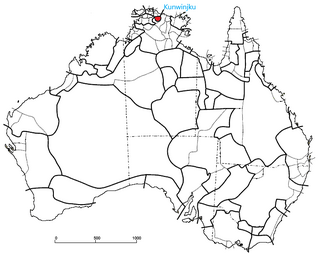
Norman Barnett Tindale AO was an Australian anthropologist, archaeologist, entomologist and ethnologist.
The Burarra people, also referred to as the Gidjingali, are an Aboriginal Australian people in and around Maningrida, in the heart of Arnhem Land in the Northern Territory. Opinions have differed as to whether the two names represent different tribal realities, with the Gidjingali treated as the same as, or as a subgroup of the Burarra, or as an independent tribal grouping. For the purposes of this encyclopedia, the two are registered differently, though the ethnographic materials on both may overlap with each other.

The Kunwinjku people are an Australian Aboriginal people, one of several groups within the Bininj people, who live around West Arnhem Land to the east of Darwin, Northern Territory. Kunwinjku people generally refer to themselves as "Bininj" in much the same way that Yolŋu people refer to themselves as "Yolŋu".
The Marranunggu are an Aboriginal Australian people and language group, of the Northern Territory.
The Nunggubuyu are an Aboriginal Australian people of eastern Arnhem Land in the Northern Territory.
The Warndarrang people, (waɳʈaraŋ), also spelt Warndarang, Wanderang, and other variants were a predominantly coastal Aboriginal Australian people of eastern Northern Territory. Though extinct as a distinct ethnolinguistic group, their descendants survive among the neighbouring Nunggubuyu.
The Ngarkat is a recorded title of a tribal group from South Australia. The Ngarkat lands had linked the mallee peoples of Victoria and South Australia to the river peoples of the Murray River Murraylands. Ngarkat language has been loosely grouped with Peramangk language though not by linguists, and the grouping was perhaps partly owed to the co-ownership of lands in both the Ninety Mile Desert and Echunga by John Barton Hack, and partly to the occasional meeting of tribes. The language of the Ngarkat was recorded as being Boraipur by Ryan in recent times though sources were not given, while it may yet be telling that the citing work concerns Mallee peoples to the east. The language may have been midway between that of mallee peoples to the east, and that of peoples to the west recorded by Teichelmann and Schurman. It is known that songlines linked the Coorong to the Mallee regions, hence went through Ngarkat land. It is also known that Ngarkat people did meet regularly with tribes to the east, at sites along the Murray.
The Wudjari were an Aboriginal Australian people of the Noongar cultural group of the southern region of Western Australia.
The Jadira are a people and territory in the Pilbara region of Western Australia.
The Djinba are an Aboriginal Australian group of the Yolngu people of the Northern Territory.
The Dhuwal are an indigenous Australian people of Arnhem Land in the Northern Territory
The Dhuwala are an indigenous Australian people of eastern Arnhem Land in the Northern Territory.
The Awarai (Warray) are an indigenous Australian people of the Northern Territory.
The Dalabon or Dangbon are an Australian Aboriginal people of the Northern Territory.
The Ngalakgan are an indigenous Australian people of the Northern Territory.
The Baiyungu are an Aboriginal Australian people of the Gascoyne region of Western Australia.
The Watta were an indigenous Australian people of the Northern Territory.
The Ngardok were an indigenous Australian people of the Northern Territory. Nothing is known of the language, which has been extinct since about WW2.
The Pongaponga were an indigenous Australian people of the Northern Territory. They may have been a band of the Ngolokwangga.
The Marra, formerly sometimes referred to as Mara, are an Aboriginal Australian people of the Northern Territory.